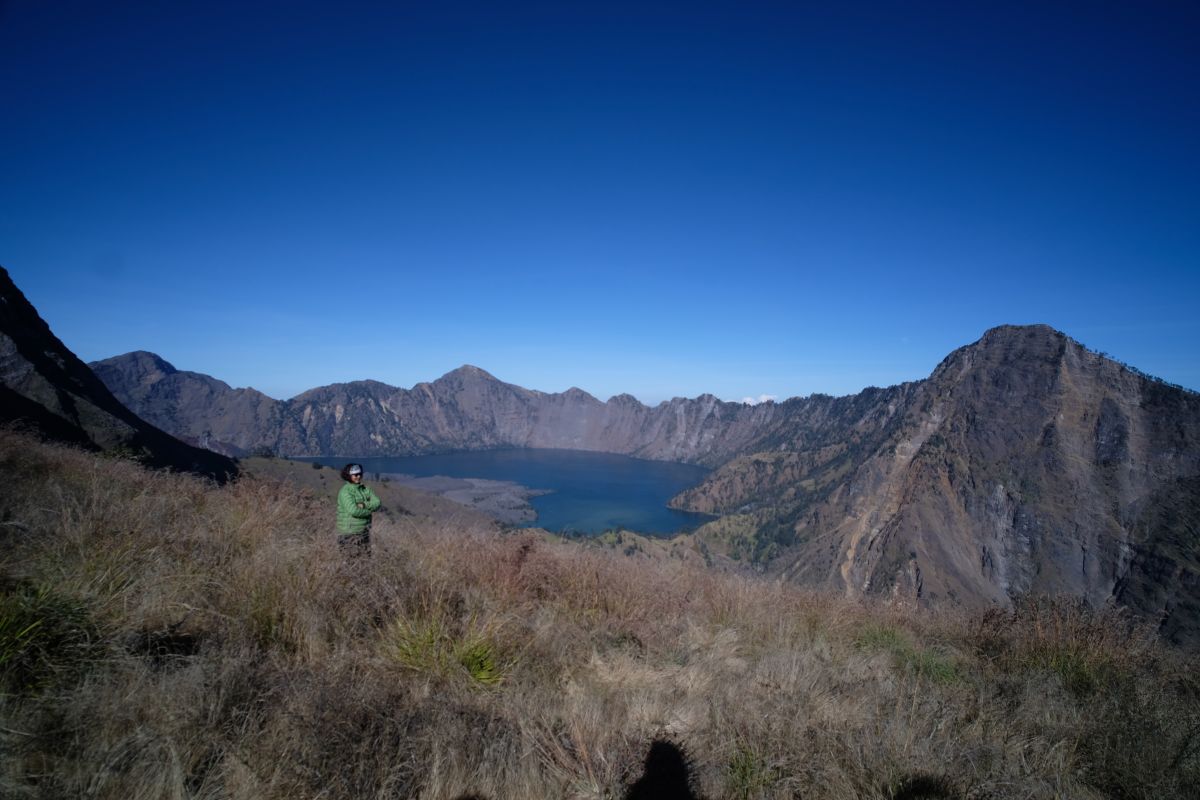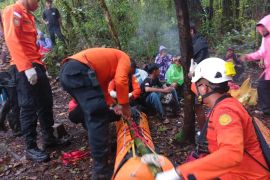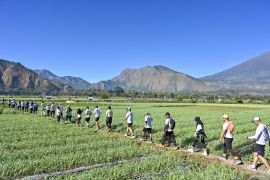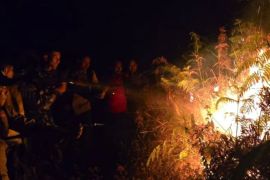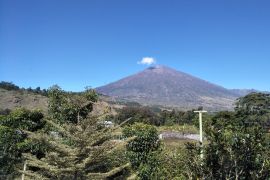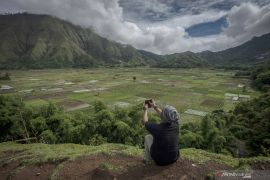Dare they say, the stunning scenery on Plawangan is akin to a painting from a faraway land, with the 3,200-Mdpl Mount Sangkareang towering in the backdrop!
So close yet feels so far away, with the blueish water surface from a nearby lake flickering as though beckoning them to wash their faces that morning.
In the first week of September, ANTARA joined several mountaineers for climbing West Nusa Tenggara Province’s pride, Mount Rinjani – a 3,726-Mdpl beauty, which is the second-highest active volcano in Indonesia.
Although we stopped at Plawangan, the last campsite before the summit, owing to bad weather, yet the journey was worth remembering. To reach Rinjani's Peak from Plawangan, mountaineers have to undertake another journey of three to four hours.
At a distance, rows of andesite rock cuts through a landscape that resembles a bowl at the edge of which lie the famous Senaru and Aik Berik hiking treks to Mount Rinjani.
Meanwhile, thin white clouds slowly drift to the surface, passing through the ravine and the path to reach Plawangan.
With such innate beauty around us and a cup of Robusta coffee from Senaru Village complementing the alluring panorama at the last campsite before Rinjani's Summit on this memorable morning after nine hours of non-stop climbing, we couldn’t help but mutter the words, "Good Morning Rinjani".
Related news: BTNGR to soon reopen Mount Rinjani's hiking trails for climbers
Related news: NTB natives reject cable car to protect, preserve Mt Rinjani
Mount Rinjani, located inside the Mount Rinjani National Park Center (BTNGR), is one of the popular hiking spots for several mountaineering clubs.
After remaining closed for nearly two years owing to the earthquake in 2018 that caused damage to some of the hiking treks, Mount Rinjani officially reopened for trekking and hiking on August 27, 2020, to quench the thirst of nature lovers.
Atop the volcano is a 6-by-8.5-kilometre (3.7 by 5.3 mi) caldera, filled partially by the crater lake known as Segara Anak owing to the blue color of its water.
This time, however, there is something extraordinary.
Due to the coronavirus disease that has gripped the world, with no signs of abating anytime soon, COVID-19 health protocols should be prioritized everywhere, and Mount Rinjani is no exception to this.
All mountaineers arriving at the BTNGR post in Sembalun Lawang are required to undergo mandatory temperature checks and hand in their health certificates that indicate their COVID-19-free status.
The Sembalun and Timbanuh routes in East Lombok, Senaru in North Lombok, and Aik Berik in Central Lombok are four climbing routes to Mount Rinjani.
Apart from the compulsory adherence to several new normal protocols, Mount Rinjani still has its own charm and allure for mountaineers to come and conquer it. They had waited patiently since months to return there to experience its alluring beauty.
Mount Rinjani has its own captivating scenery, right from the start of the trek from Bauk Nau, Sajang, Sembalun Village, with an endless savanna. We chose Sembalun as the starting point since the route is friendlier.
Throughout our journey to Plawangan, Mount Rinjani silently followed in the background, bewitching the mind and eyes, as the intertwining of the mountain ridge resembled muscular fingers gripping the earth.
It was an hour later when we arrived at Post 1, the first stop to reach the peak. There are four posts, a campsite area, overall to the peak.
Our bodies were drenched in sweat, as the sun shone brightly all through our journey. The dry, humid weather left dust flying everywhere each time we set foot on the rocky route.
However, a glimpse of the tiny tin roof behind the mountain ridge at a distance that is none other than Post 2 would always instill new energy and lighten the footsteps to continue climbing.
Until Post 3, the scenery is not much different, with the savanna all around us. We spent an hour to reach Post 2 from Post 1 and another two hours to reach Post 3 from Post 2.
Towards Post 3, climbers have to descend a ridge to a black rocky river, the evidence of a past eruption, a petrified lava.
"This is a new route, we should just go straight in the past, but now, it is closed because it is prone to landslides after the earthquake," one of the porters, Jhoni Iskandar, known as Bang Jon, stated.
Walking along the river left us with goosebumps as the mist slowly descended and covered the path on the dry river akin to a mysterious gate in the middle of nowhere in an horror movie.
However, the real challenge is about to begin. The endless sharp incline awaited us. Physical and mental readiness are crucial to fulfill the promise of reaching Rinjani Peak.
This challenge presented itself when we began our journey to Plawangan from Post 4. To reach Plawangan, mountaineers have to traverse the Hill of Regret, a 60-degree incline that is named as a reminder for those climbers to not regret their decision to conquer the mighty Rinjani. There was hardly time to catch a breath while scaling the Hill of Regret.
However, there is no reason to feel discouraged since a stunning view enthralls us as we glance around. A circular high hill strand: Pergasingan Hill and Anak Dara Hill.
Here, every now and then, the wind drove away the fog covering the ridge towards the peak and offered us a glimpse of Rinjani’s pristine beauty, a reminder of how grand nature is.
However, conquering the Hill of Regret, does not mean that the struggle is over. A similar incline, if not sharper, was awaiting us. However, there was no sense in giving up. All climbers remained resolute to pass it despite experiencing shortness of breath.
Towards Plawangan, we passed through a steep incline with a gaping cliff on our left side. Everybody must always remain on guard, taking one step at a time until they reach the Plawangan Peak. Our team needed at least three hours to reach the peak from Post 4.
"Indeed, no one will get tired of climbing Mount Rinjani. I have climbed in 2006 but always want to come again," Nurlaela Ramli, a climber from Bandung currently residing in the island of Bali, stated.
Nurlaela Ramli came along with her husband Rifki Areadi, who is also a mountaineer and member of the same mountaineering organization, the University of Padjadjaran Mountaineering Club, Palawa.
Nurlaela admitted that the enchanting nature, right from the start of the trek to Plawangan and Segara Anak Lake was the key attraction.
"However, unfortunately, we are still banned from going down to Segara Anak Lake this time," she remarked.
Moreover, the duration for climbing is limited to only two days and one night.
"It was so unfortunate. Ideally, three days and two nights at the very least are needed to enjoy the peak and lake,” she pointed out.
Her husband echoed a similar sentiment. Areadi said if the climbers have three days and two nights in their hands, they can ascend from Sembalun, East Lombok, and descend in Senaru, North Lombok. He lamented the limited time they had to enjoy the beauty of Rinjani.
In the meantime, several climbers have criticized the unclear directions along the way. They mostly complained of the signs being too old to decipher or understand them properly.
Not to mention the garbage issue, although it becomes a cliché, still it should be addressed properly. It is necessary to remind everyone not to discard trash on the mountain.
However, despite all, Mount Rinjani is calling. Hence, let's say, "Good Morning, Rinjani".
Related news: Volcanic activities of Mt Agung, Mt Rinjani remain normal: Disaster Mitigation Center
Related news: 1,091 climbers evacuated from Mount Rinjani
Editor: Sri Haryati
Copyright © ANTARA 2020
